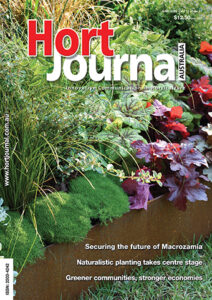
Lifelong learning and fascination
When people ask why I chose horticulture as a career, I usually respond that I love the fascination of nature. If I lived ten lifetimes, I would only be scratching the surface of all there is to learn. I gain new knowledge at every event, conference, trek, or bushwalk, and from many of the conversations that take place on such occasions. I have been hooked on Sir David Attenborough’s documentaries and books for decades;, what an inspiration he is!
Just recently, my friend Russell Dobbs asked if I knew anything about black bamboo. I have not personally grown bamboo, though I have had some experience with it in landscaping. Russell was concerned for his neighbour’s black bamboo hedge, which had suddenly died, entirely, all at once, with no gradual decline. He was worried the neighbours would think he had poisoned it. After some research, he discovered ‘monocarpic death’ in bamboo species. Many plants are monocarpic, including certain succulents and bromeliads. I did some research myself and found that black bamboo (Phyllostachys nigra var. henonis) has a remarkably long flowering cycle, up to 120 years!
Semelparous masting, also known as monocarpic death, refers to a phenomenon where a typically long-lived plant species reproduces only once in its lifetime, producing a large and synchronised seed production event (masting) before dying. This contrasts with iteroparous masting, where plants reproduce multiple times over their lifespan. The timing of masting is believed to be regulated by an internal clock, though the exact mechanism is still not fully understood. Most fascinating of all is the synchronisation of an entire species flowering, setting seed, and dying simultaneously across continents.
Semelparous plants devote their whole lives to growth and development until they reach maturity and reproduce once, yielding a large seed crop. After that single reproductive event, the parent plant dies, and the cycle begins again with the new generation of seedlings. While the seeds can regenerate new bamboo plants, it takes years for them to reach maturity.
What was I saying about living ten lifetimes and still only scratching the surface? Nature is brimming with these incredible phenomena! How can anyone not be intrigued?
Think of plants like Welwitschia mirabilis, which can live for over 1,000 years in the middle of the desert, drawing water from deep underground. Or the rare Amorphophallus titanum, with its enormous, pungent flower. One of my favourite plants is the giant water lily (Victoria amazonica), with its large, strong circular leaves. Then there are plants that use mimicry for survival, such as lithops that resemble stones and orchids that look like insects.
Choosing horticulture for a career for me was an easy choice to make. Sure, every career has a downside, such as working in all the elements, sometimes heavy and strenuous work, but at the end of the day its all about the plants and what’s not to love about that? The fascination never ends.
There is never a dull moment in nature, so take a moment to notice the wonder woven into the ordinary!
Enjoy the read
Karen Smith and your Hort Journal Team
